
- SAP - Home
- SAP - Evolution of SAP
- SAP - Introduction To ERP
- SAP - Modules
- SAP - Architecture
- SAP - GUI Installation
- SAP - Net Weaver
- SAP - Logging onto SAP System
- SAP - GUI Customization
- SAP - End-User Customization
- SAP - GUI Navigation
- SAP - Programming Language (ABAP)
- SAP - SAP Security
- SAP - SAP Basis
- SAP - Transaction Codes
- SAP - Project Lifecycle
- SAP - Career In SAP
SAP - Modules
SAP solutions include a number of functional modules, which support transactions to execute key business processes, such as −
- Financial Accounting (FI)
- Financial Supply Chain Management (FSCM)
- Controlling (CO)
- Materials Management (MM)
- Sales and Distribution (SD)
- Logistics Execution (LE)
- Production Planning (PP)
- Quality Management (QM)
- Plant Maintenance (PM)
- Project System (PS)
- Human Resources (HR)
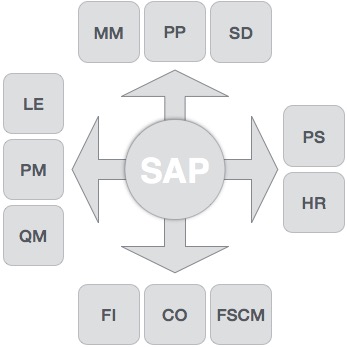
Finance and Controlling (FICO)
SAP FICO is a combination of two ERP modules, i.e., Finance Accounting (FI) and Controlling (CO). Under Finance in SAP and at an enterprise level, the following modules take part −
- FI − Finance
- CO − Controlling
- IM − Investment Management
- TR − Treasury
- EC − Enterprise Controlling
SAP FI (Financial Accounting) is accountable for tracking the flow of financial data across the organization in a controlled manner and integrating all the information for effective strategic decision-making.
Activities Involved in SAP FI
Creation of Organizational Structure (Defining Company, Company Codes, business Areas, Functional Areas, Credit Control, Assignment of Company Codes to Credit Controls)
Financial Accounting Global Settings (Maintenance of Fiscal Year, Posting Periods, defining Document types, posting keys, Number ranges for documents)
General Ledger Accounting (Creation of Chart of Accounts, Account groups, defining data transfer rules, creation of General Ledger Account)
Tax Configuration & Creation and Maintenance of House of Banks
Account Payables (Creation of Vendor Master data and vendor-related finance attributes like account groups and payment terms)
Account Receivables (Creation of Customer Master data and customer-related finance attributes like account groups and payment terms
Asset Accounting
Integration with SD and MM
SAP CO (Controlling) module facilitates coordinating, monitoring, and optimizing all the processes in an organization. It controls the business flow in an organization. This module helps in analyzing the actual figures with the planned data and in planning business strategies.
Two kinds of elements are managed in CO −
- Cost elements
- Revenue elements
These elements are stored in the FI module.
Activities Involved in SAP CO
Cost Element Accounting (Overview of the costs and revenues that occur in an organization)
Cost Center Accounting
Activity-Based-Accounting (Analyzes cross-departmental business processes)
Internal Orders
Product Cost Controlling (Calculates the costs that occur during the manufacture of a product or provision of a service)
Profitability Analysis (Analyzes the profit or loss of an organization by individual market segments)
Profit Center Accounting (Evaluates the profit or loss of individual, independent areas within an organization)
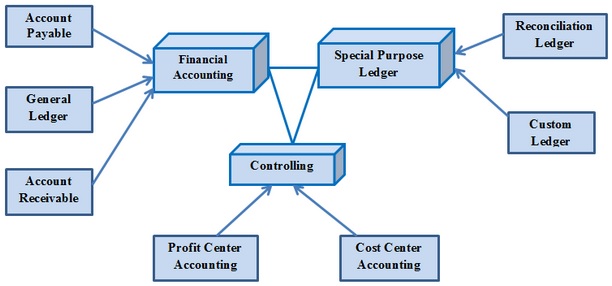
Sales & Distribution Management (SD)
SAP SD is one of the most important modules in SAP. It has a high level of integration complexity. SAP SD is used by organizations to support sales and distribution activities of products and services, starting from enquiry to order and then ending with delivery.
SAP SD can monitor a plethora of activities that take place in an organization such as products enquires, quotation (pre-sales activities), placing order, pricing, scheduling deliveries (sales activity), picking, packing, goods issue, shipment of products to customers, delivery of products and billings.
In all these processes, multiple modules are involved such as FI (Finance Accounting), CO (Controlling), MM (Material Management), PP (Production Planning), LE (Logistics Execution), etc., which shows the complexity of the integration involved.
Activities Involved in SAP SD
Setting up Organization Structure (creation of new company, company codes, sales organization, distribution channels, divisions, business area, plants, sales area, maintaining sales offices, storage location)
Assigning Organizational Units (Assignment of individual components created in the above activities with each other according to design like company code to company, sales organization to company code, distribution channel to sales organization, etc.)
Defining Pricing Components (Defining condition tables, condition types, condition sequences)
Setting up sales document types, billing types, and tax-related components
Setting up Customer master data records and configuration
Material Management (MM)
Material Management deals with movement of materials via other modules like logistics, supply chain management, sales and delivery, warehouse management, production and planning.
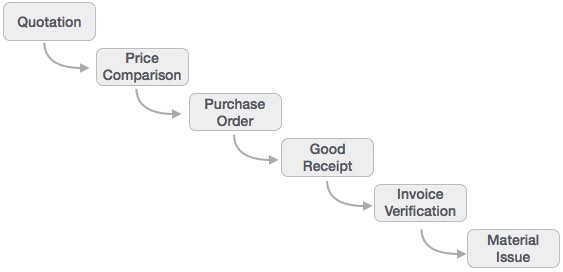
Logistic Execution (LE)
Logistic Execution can be divided into two sub-modules, i.e., shipment of goods (purchase to procurement process) and warehouse management (storage of goods). These two modules are integrated with sale and distribution, material management, and production and planning.
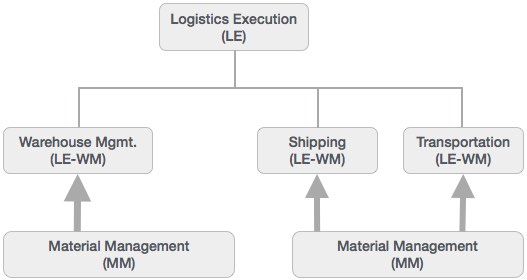
Supplier Relationship Management (SRM)
As the name SRM suggests, this module deals with the effective and efficient transition of products and services between an organization and its suppliers. The main process covered in this section is procurement of products like direct materials, indirect materials, and services. This module can effectively integrate with planning, accounting, and inventory system.
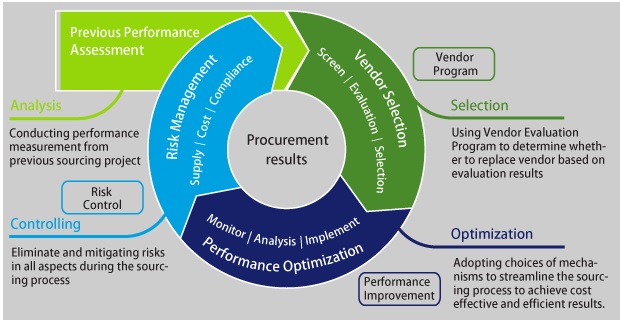
End-to-End Procurement Cycle
Procurement process with SAP Enterprise Buyer comprises of the following major steps −
- Shopping Carts
- Approval of Shopping Cart
- Sourcing of Requirements
- Purchase Orders
- Purchase Order Approval
- Confirm Goods/Services
- Confirmation Approval
- Process Invoice
- Invoice Approval
Customer Relationship Management (CRM)
CRM deals with end-to-end customer related processes. CRM is designed to centralize the data related to all the customers associated with an organization. It helps an organization −
Maintain its sales, services, and build marketing strategies according the market demand and customer data analysis.
Remain focused on its customers and via information analysis, help the business to know more about its customers.
Improve sales and services and building better relationships with customers.
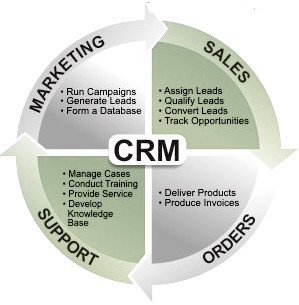
Human Resource (HR)
The most important objective of master data administration in Human Resources is to enter employee-related data for administrative, time-recording, and payroll purposes.
A new employee can be hired without using Recruitment. Instead you can hire someone by running a personnel action in Personnel Administration, thereby creating the necessary data for the employee to be hired.
Employee data must be kept current. After an employee is hired, circumstances can always arise which necessitate either the entry of new data or the correction of current data. For instance −
An employee moves to his or her new address must be stored in the system.
An employee gets a pay hike at the start of the year. The new salary must be stored for the relevant date.
An employee changes jobs within the organization. His or her organizational assignment, working time, and salary also change.
Data can be stored for the past, present, or future.
Note − Entering payroll-relevant data in the past triggers retroactive accounting.
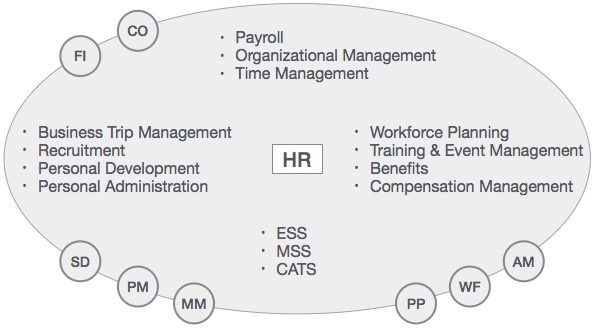
The HR module is comprised of major areas of functionality known as sub-modules. The HR module is a true demonstration of the strength of the SAP product in Enterprise Resource Planning.
The HR system has very strong integration points (where data is passed back and forth without human intervention) with just about all of the other SAP modules. In addition, there is very tight integration amongst the HR sub-modules.
The above illustration highlights some of the basic SAP HR terms as listed below.
- Business trip management
- Recruitment
- Payroll
- Personal development
- Organizational Management
- Time Management
- Workforce Planning
- ESS
- MSS
- Training and event management
- CATS
- Benefits
- Compensation management
- Personal Administration